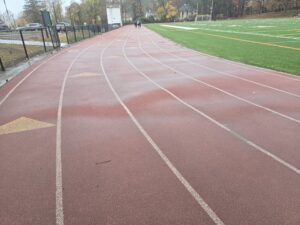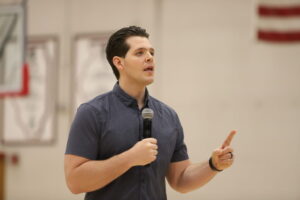By Wyatt McInerney
Irvington Senior Brooke Dunefsky is already revolutionizing the medical world.
While interning at a stroke rehabilitation center, Brooke noticed that the devices used were expensive, complex and could not be used at home. So she got to work creating a simpler design. Over the past the past couple years, Brooke has invented and refined a simple 3D-printed device that uses neuroscience principles to promote rehabilitation. It costs just under $100 dollars to make and can be used at home. She now has a patent.
In an interview with Brooke, she revealed more details about her project and process:
Could you begin with just trying to explain your inspiration for designing this device?
I was inspired to build my stroke rehabilitation device while interning at the Icahn School of Medicine at Mt. Sinai Hospital in New York City the summer after ninth grade. At this stroke rehabilitation center and innovation lab, I was able to observe what the typical rehabilitation process looks like. While I am thrilled to have had this experience and to have learned so much, I quickly realized the limitations of current technology. Highly expensive equipment and advanced technology was hard for patients to actually interact with. Even technology that made sense from a scientific standpoint could be ineffective simply because stroke patients with upper limb motor impairment could not hold onto the technology. I wanted to address this issue in an affordable manner since socioeconomic disparities can often prevent those who need help the most from obtaining it.
How did you come up with the idea for this device, and did you think you would ever get to this point with this idea?
I could see from working with stroke victims with upper limb impairment that many of them had difficulty rotating their arms and wrists in a 180-degree arc, which is so important to being able to return to normal function after a stroke. So, I decided to see if I could create a simply apparatus that they could grip and rotate easily to be able to perform these exercises. The lab had a 3D printer, so after I taught myself how to use it, I designed the first simple prototype of the device and tried it out with a stroke patient who happened to be a doctor. He was impressed with it, and encouraged me to develop and patent it. At that time, however, I did not expect to go much further with it. Then in 10th grade I started thinking about how I could improve the device, making it more responsive to the differing needs of stroke patients. By happenstance, around the same time I learned about MIT’s THINK competition, where students submitted ideas that they have for new technologies with the hope of winning the competition and getting assistance from MIT to develop them. In early 2020, I was one of the winners, and received funding, mentorship and a trip to MIT to further design and build it. And that is what I did over the next 5 months.
If you could put in basic terms, what does your device do?
My device has a soft handle which the stroke patient grips to perform movements called pronation and supination movements that help in stroke recoveries. The device also uses magnetic currents to create varying levels of resistance. When a neodymium magnet is moved closer to the metal flywheel that the patient turns, the resistance increases. As the patient improves and gets stronger, the resistance can be changed to make it more challenging for them to perform these movements.
What were some problems you encountered when making this device, and how were you able to get around them?
The coronavirus pandemic began just as I started working with MIT, and unfortunately, like many people worldwide, it had an impact on my work. I was not able to physically go into welding/mechanical shops to create or even purchase necessary parts for the device. This made it harder for me to acquire all of the materials I needed. But it actually had a positive effect too. It forced me to be resourceful. For example, with funding from MIT, I purchased a 3D printer, which allowed me to design and print some of the key parts of the device and make them as personalized as possible. I believe that having less typical resources to work with was an interesting challenge and ultimately furthered the development of my engineering abilities, as well as my ability to find creative solutions for the development of the device.
Something I believe many are wondering, what’s next for you?
In college I plan to study neuroscience and engineering, so I can further my knowledge in these areas. I think there will be so much room for improvement in patients’ outcomes at the intersection of these two fields, and I definitely want to be one of the people who help come up with the solutions.










Be First to Comment